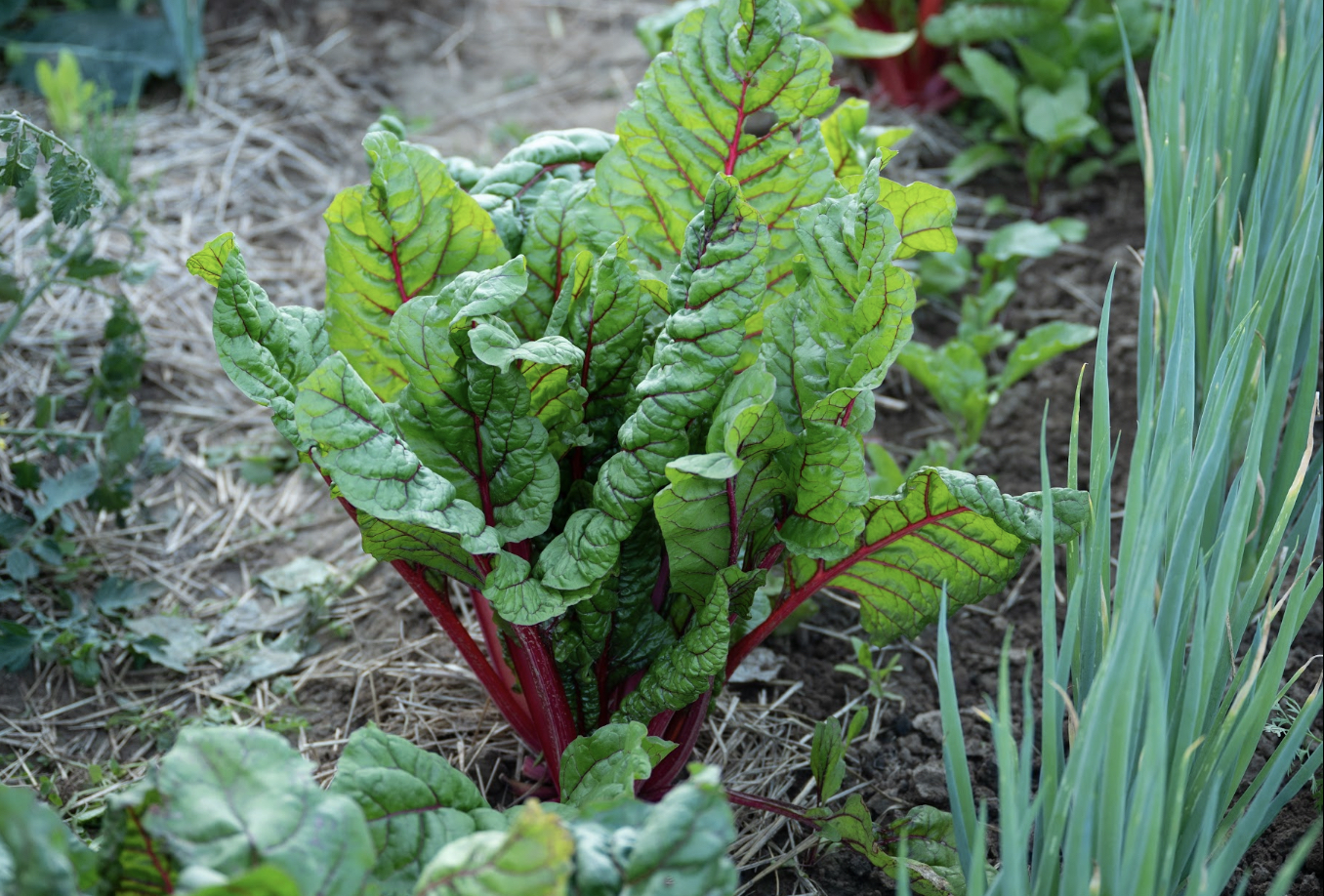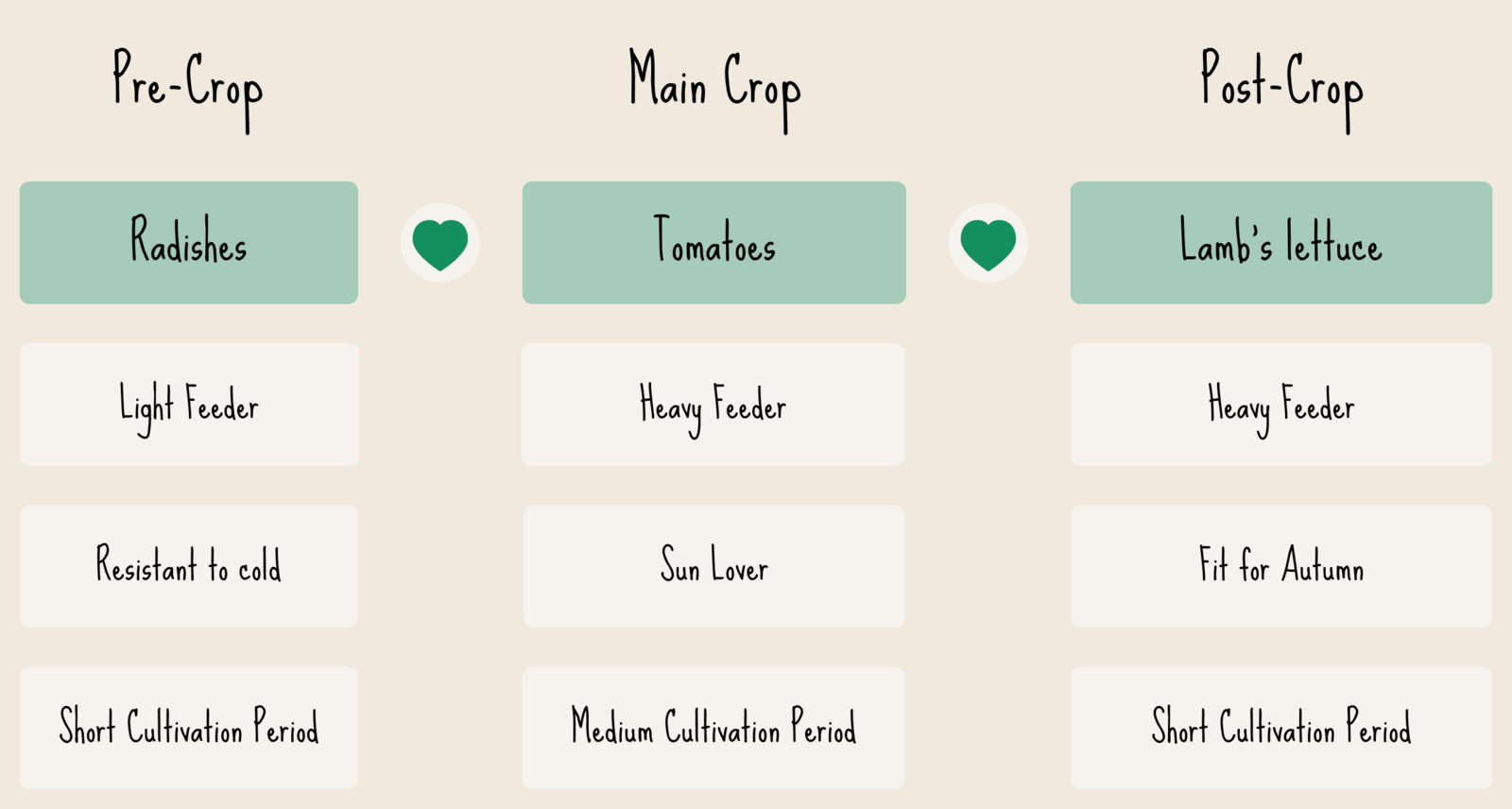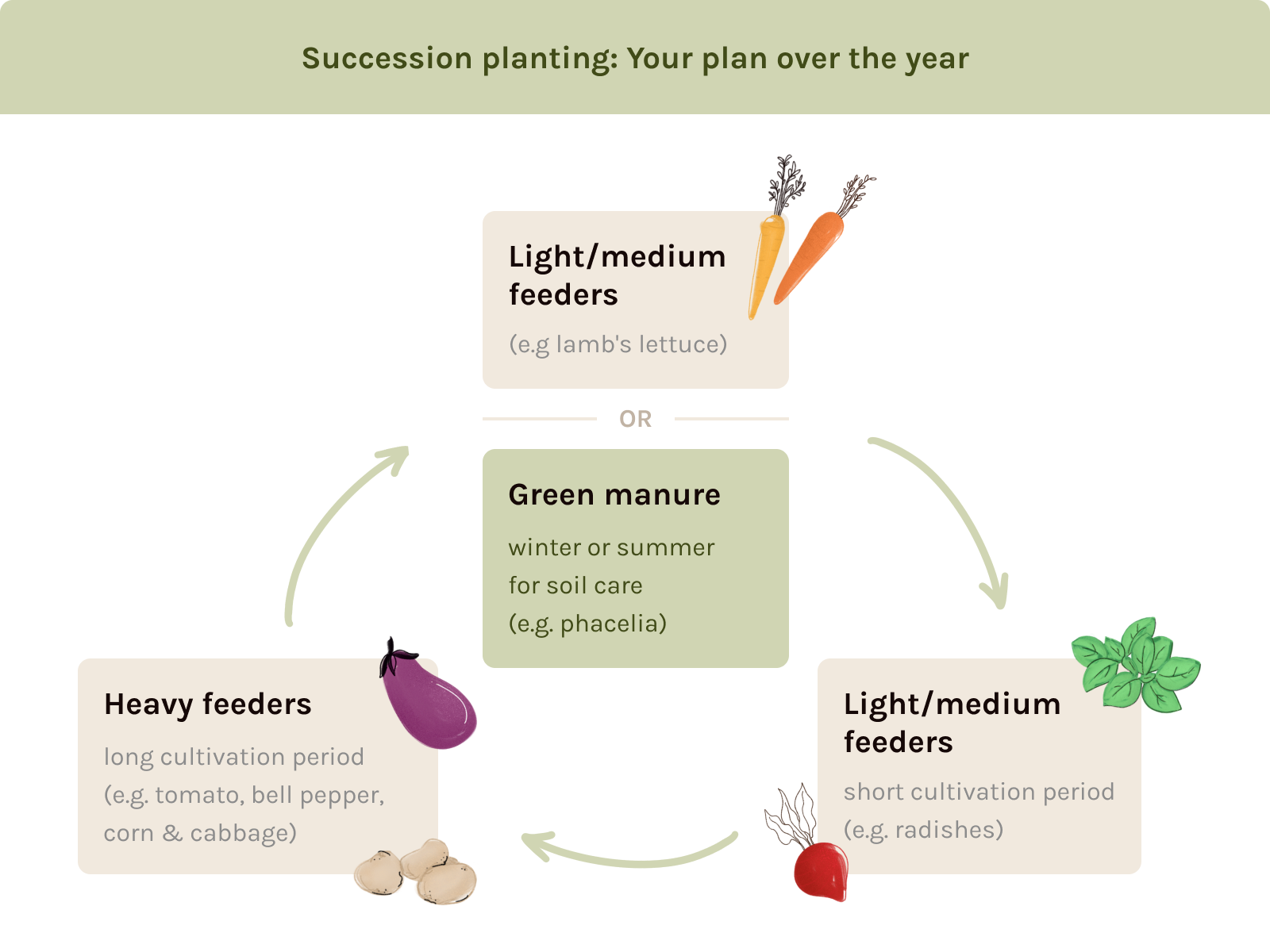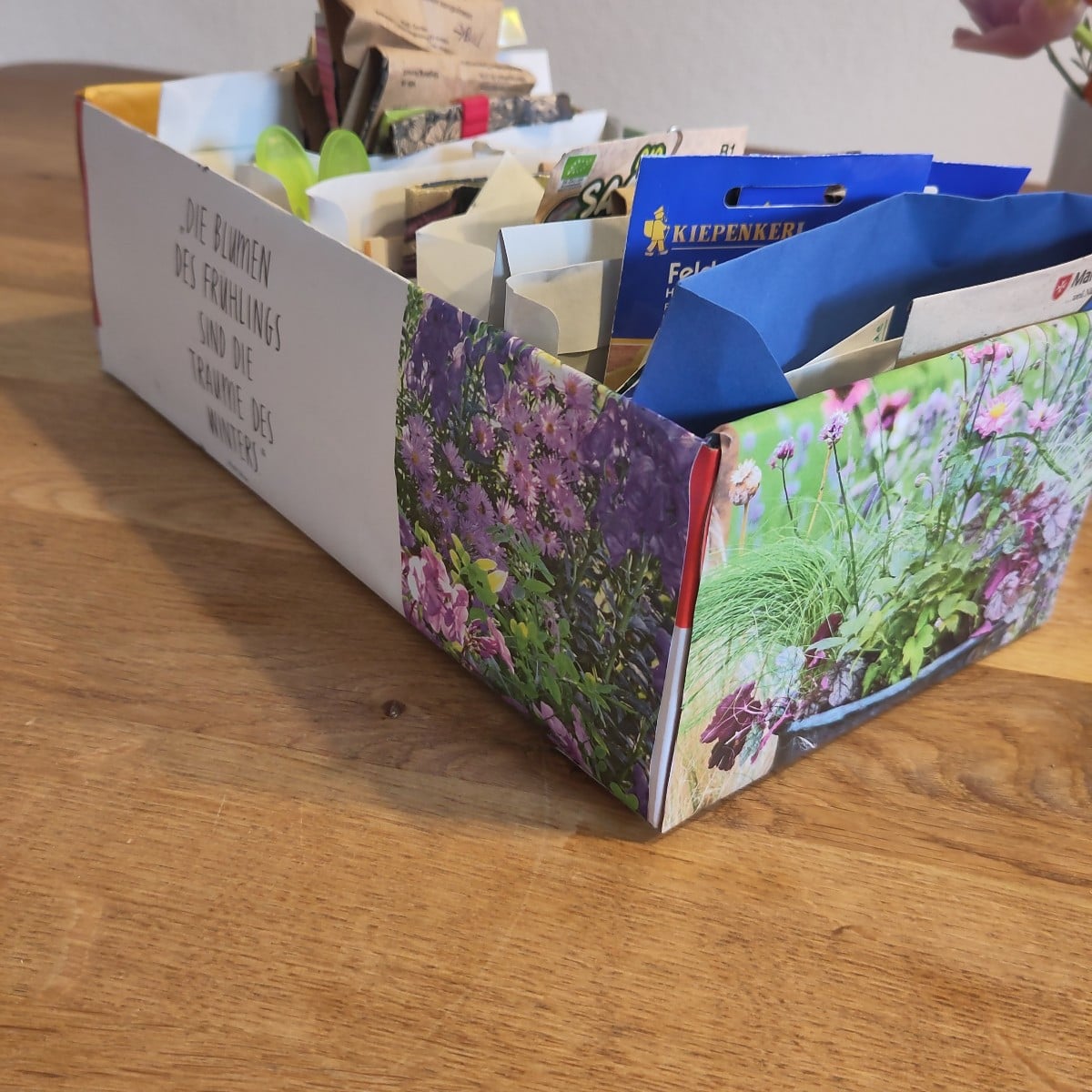
Succession Planting: Heavy, Medium and Light Feeders
There are a few things to consider when planning succession planting as not to strain the soil. The division of plants into heavy-, medium- and light-feeders is important for planning your beds throughout the year.
In this article, we explain what succession planting is and how you can plan it for your beds. Find out what heavy-, medium- and light-feeders are. We also provide you with a chart in which you can see the nutrient requirements of different crops at a glance.
This Article Contains:
- What Is Succession Planting?
- Advantages of Succession Planting in the Vegetable Garden
- Table: Good Pre- And Post-crops in the Vegetable Patch
- How to Create a Succession Plan
- About Heavy-, Medium- And Light-Feeders
- Succession Planting: List of Heavy-, Medium- And Light-Feeder Crops
- Heavy-, Medium- And Light-Feeder Crops: Soil Preparation & Fertilization
- Frequently Asked Questions About Succession Planting
Quick Overview
What Is Sucession Planting?
- Rotation of different crops on a bed within a year
- The nutrient requirements of the crops play an important role here and they are divided into heavy-, medium- and light-feeders
Create a Good Succession Plan
- Pre-cultivation: medium- or light-feeder
- Main crop: heavy-feeders (summer or winter crop)
- Subsequent crop: Medium- or light-feeder
- Green manure
Succession Planting & Fertilization
- Heavy-feeders: high nutrient requirements; soil preparation and fertilization during the season
- Medium-feeders: medium nutrient requirements; several fertilizer applications during the season
- Light-feeders: no additional fertilization
What Is Succession Planting?
Succession planting means growing different crops on the same area within one season. For example, if you first grow early potatoes in a bed and then sow spinach in the same bed after harvesting the potatoes, this is succession planting. A well-thought-out succession plan allows you to make the most of the growing season. In Central Europe, the growing season lasts roughly from April to November, during which time as many crops as possible should be planted. When planning your vegetable garden, you should therefore make sure that you take into account the optimum growing times for the individual crops and plan the planting of your beds accordingly.
In addition to succession planting, you should also keep your beds as varied as possible over several years. Rotating different crops over several years is called crop rotation. You can find out more about Crop Rotation in the Vegetable Garden here.
Advantages of Succession Planting in the Vegetable Garden
A balanced succession plan prevents your garden soil from being depleted to one side. This helps to maintain soil fertility. In addition, the soil is planted all year round, which benefits soil life on the one hand. On the other hand, the soil is protected from erosion and silting.
But you as a gardener also benefit from a good succession plan. The space in the bed is used optimally, as it is planned with planting throughout the season. This means there are no empty spaces before or after a main crop.
In order To Garden as Sustainably and Ecologically as possible, you should plan your beds in mixed crops. You can find out How to Plan a Mixed Crop in the Vegetable Patch in our article. Based on the information about good and bad companion plants, the cultivation period and the nutrient requirements of a plant - i.e. whether it is a heavy-, medium- and light-feeder - all crops can be optimally distributed over the year and the beds. It makes sense to divide all plants into three categories: Pre-crop, main crop and post-crop.

Table: Good Pre- And Post-crops in the Vegetable Patch
| Good Pre-crops | Good Post-crops |
|---|---|
| chard | chard |
| field beans | field beans |
| herbs | garlic |
| kohlrabi | herbs |
| lamb's lettuce | kohlrabi |
| peas | lamb's lettuce |
| radishes | peas |
| rocket salat | phacelia |
| radish and radishes | |
| rocket | |
| spinach |
How to Create a Succession Plan
For a good succession plan, alternate between different crops in your beds: medium- or light-feeder crops are followed by a heavy-feeder as main crop. The main crop is usually the longest on the field. Pre- and post-crops have a shorter cultivation period and must be adapted to the temperatures. After the sequence of pre-crop, main crop and subsequent crop, the soil is happy to have a break. To do this, you can sow a green manure that covers the soil but does not remove any nutrients from it. This increases soil health.
The main crop can be either in summer or winter. In our latitudes, we usually plant a heat-loving main crop such as tomatoes or zucchinis in the summer in hobby gardens and plan around it. To provide yourself with vegetables all year round, you can also plant main crops such as cabbage in winter. You can find more information about Growing Vegetables in Winter here. To keep an overview, it makes sense to enter the sowing dates of the different types of vegetables in a calendar. This way, you will always know when to start growing or sowing in the vegetable patch.

About Heavy-, Medium- And Light-Feeders
The three terms describe the general nutrient requirements of a plant. The concept of heavy-, medium- and light-feeders does not, of course, adequately describe the needs of individual plants. Many plants have special requirements regarding the composition of the nutrients they receive from the fertilizer. However, the division into the three categories provides a rough overview and also offers a reference point for bed planning. Here you will find a chart with an overview of heavy-feeders, medium-feeders and weak-feeders.
Succession Planting: List of Heavy-, Medium- And Light-Feeder Crops
| Heavy Feeders | Medium Feeders | Light Feeders | Green Manure |
|---|---|---|---|
| aubergine | beans | garlic | beans |
| cabbage | beetroot | herbs | buckwheat |
| courgette | carrots | lamb's lettuce | lupin |
| cucumber | celery | lettuce | mustard |
| leek | chard | peas | oil radish |
| potato | fennel | radishes | phacelia |
| pumpkin | flowers | sunflower | vetch |
| rhubarb | garlic | ||
| sweet corn | kohlrabi | ||
| sweet pepper | onion | ||
| sweet potato | parsnip | ||
| tomato | radish | ||
| rocket | |||
| spinach | |||
| strawberries |

Discover the Fryd Library!
In our library you will find a variety of plants with their nutrient requirements and other cultivation tips. You will also find good and bad neighbors to help you plan a mixed crop.
View Library NowHeavy-, Medium- And Light-Feeder Crops: Soil Preparation & Fertilization
Depending on your nutrient requirements, you may need to prepare your bed so that enough nutrients are available for the plant during the growing season. With the No Dig Method, your beds are prepared once a year with compost for the whole season. Alternatively, you can also fertilize your beds depending on the planting. You can find tips on soil preparation and Fertilization here:
- Heavy-feeders need the most nutrients and require a balanced soil environment. It is usually not enough to simply fertilize them with liquid fertilizer a few times during the gardening season. To achieve the best results, you should prepare your bed of heavy-feeders before you plant them. Compost or green manure with plants that enrich nutrients are suitable for this. You can find out how you can Improve Your Garden Soil Easily and Naturally in our article.
- Medium-feeders are not quite as demanding as heavy-feeders and do not require any extra bed preparation. They can, for example, be cultivated on a bed that was used to grow heavy-feeders the previous year. A few applications of liquid fertilizer over the summer are usually enough to exploit the full potential of these plants.
- Plants that make no particular demands on the nutrient content of the soil and can manage with just a few nutrients are generally referred to as light-feeders. These plants often do not require any additional fertilization.
If you have any questions or comments, please write to us at [email protected]. Would you like to receive helpful gardening tips all year round and plan your own beds optimally? Then register here or download the Fryd app for Android or iOS.
Fryd - Your digital bed planner

Marie
Marie is an agronomist. She is particularly interested in the sustainable and organic cultivation of vegetables and other plants. In her own garden, she gained experience and likes to try things out to learn from nature. She is particularly interested in the values and principles of permaculture, in order to contribute not only to the well-being of nature, but also to the well-being of people and future generations.
Learn MoreCurrent Topics in the Community

Where can private individuals obtain seeds for sunflowers that can be used as oilseeds? (Farmers here receive their own contracts for huge quantities.)

Liked 1 times
I feel like I'm back home 😶🌫️ #HamburgWeather

Liked 4 times
I'll start a round of seed box inspiration 😍😘
Popular Articles

Overwintering Parsley: How to Do It Successfully

How to Grow Lettuce in Winter: Varieties, Sowing, Harvesting

Growing Sage Plant: Tips for Sowing and Harvesting

What Herbs Can Be Planted Together?

Create & Design a Permaculture Garden

Overwintering Plants: Tubs, Pots and Raised Beds

Pruning, Fertilizing & Propagating Currants: Care Tips

Pruning Raspberries: How to Do It

Vegetable Garden With Greenhouse: How to Use Greenhouse Effect

Winterizing Beds and the Garden: How to Do It
FAQ
What is succession planting in the vegetable garden?
Succession planting is the alternation of different crops on a bed within a year, based on their nutrient requirements, so as not to deplete the soil.
Which plants are heavy-feeders, medium-feeders and light-feeders?
Heavy-feeders are plants with high nutrient requirements such as cabbage and tomatoes. Medium-feeders have a medium nutrient requirement and light-feeders get by with few nutrients.
How do you plan a succession planting?
For a succession plan in the vegetable garden, plan either medium- or light-feeders after a heavy feeders. Another alternative is green manure, which you can sow for soil fertility.
What is the importance of succession planting for soil health?
Succession planting prevents your soil from being depleted and too many nutrients from being extracted. This preserves soil fertility in the long term.